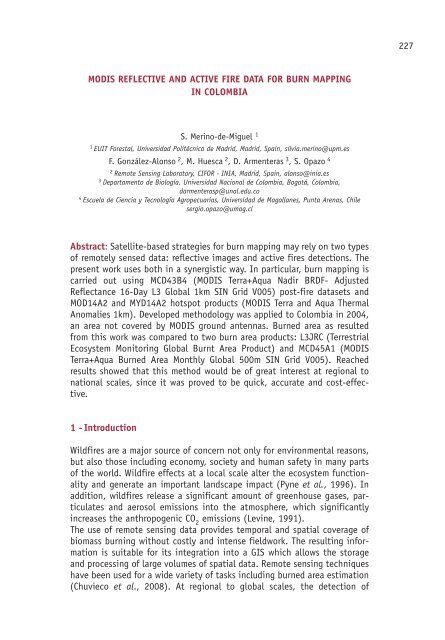7th Workshop on Forest Fire Management - EARSeL, European ...
7th Workshop on Forest Fire Management - EARSeL, European ...
7th Workshop on Forest Fire Management - EARSeL, European ...
Create successful ePaper yourself
Turn your PDF publications into a flip-book with our unique Google optimized e-Paper software.
MODIS REFLECTIVE AND ACTIVE FIRE DATA FOR BURN MAPPING<br />
IN COLOMBIA<br />
S. Merino-de-Miguel 1<br />
1 EUIT <strong>Forest</strong>al, Universidad Politécnica de Madrid, Madrid, Spain, silvia.merino@upm.es<br />
F. G<strong>on</strong>zález-Al<strong>on</strong>so 2 , M. Huesca 2 , D. Armenteras 3 , S. Opazo 4<br />
2 Remote Sensing Laboratory, CIFOR - INIA, Madrid, Spain, al<strong>on</strong>so@inia.es<br />
3 Departamento de Biología, Universidad Naci<strong>on</strong>al de Colombia, Bogotá, Colombia,<br />
darmenterasp@unal.edu.co<br />
4 Escuela de Ciencia y Tecnología Agropecuarias, Universidad de Magallanes, Punta Arenas, Chile<br />
sergio.opazo@umag.cl<br />
Abstract: Satellite-based strategies for burn mapping may rely <strong>on</strong> two types<br />
of remotely sensed data: reflective images and active fires detecti<strong>on</strong>s. The<br />
present work uses both in a synergistic way. In particular, burn mapping is<br />
carried out using MCD43B4 (MODIS Terra+Aqua Nadir BRDF- Adjusted<br />
Reflectance 16-Day L3 Global 1km SIN Grid V005) post-fire datasets and<br />
MOD14A2 and MYD14A2 hotspot products (MODIS Terra and Aqua Thermal<br />
Anomalies 1km). Developed methodology was applied to Colombia in 2004,<br />
an area not covered by MODIS ground antennas. Burned area as resulted<br />
from this work was compared to two burn area products: L3JRC (Terrestrial<br />
Ecosystem M<strong>on</strong>itoring Global Burnt Area Product) and MCD45A1 (MODIS<br />
Terra+Aqua Burned Area M<strong>on</strong>thly Global 500m SIN Grid V005). Reached<br />
results showed that this method would be of great interest at regi<strong>on</strong>al to<br />
nati<strong>on</strong>al scales, since it was proved to be quick, accurate and cost-effective.<br />
1 - Introducti<strong>on</strong><br />
Wildfires are a major source of c<strong>on</strong>cern not <strong>on</strong>ly for envir<strong>on</strong>mental reas<strong>on</strong>s,<br />
but also those including ec<strong>on</strong>omy, society and human safety in many parts<br />
of the world. Wildfire effects at a local scale alter the ecosystem functi<strong>on</strong>ality<br />
and generate an important landscape impact (Pyne et al., 1996). In<br />
additi<strong>on</strong>, wildfires release a significant amount of greenhouse gases, particulates<br />
and aerosol emissi<strong>on</strong>s into the atmosphere, which significantly<br />
increases the anthropogenic CO 2 emissi<strong>on</strong>s (Levine, 1991).<br />
The use of remote sensing data provides temporal and spatial coverage of<br />
biomass burning without costly and intense fieldwork. The resulting informati<strong>on</strong><br />
is suitable for its integrati<strong>on</strong> into a GIS which allows the storage<br />
and processing of large volumes of spatial data. Remote sensing techniques<br />
have been used for a wide variety of tasks including burned area estimati<strong>on</strong><br />
(Chuvieco et al., 2008). At regi<strong>on</strong>al to global scales, the detecti<strong>on</strong> of<br />
227
















